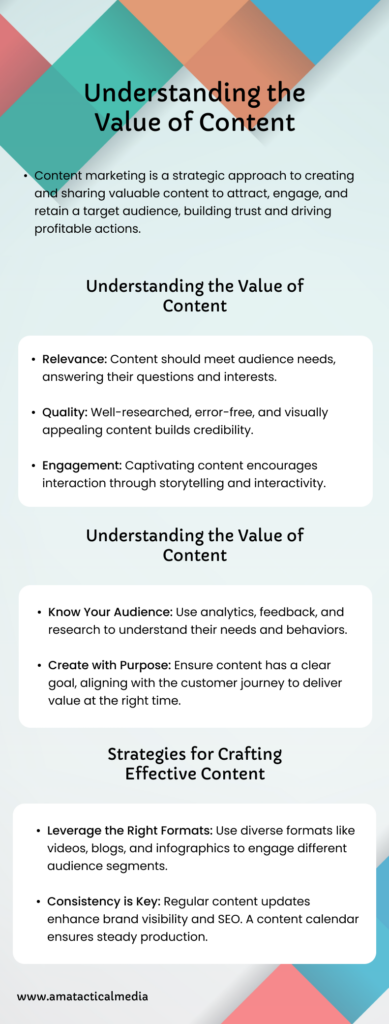
Article | Published: February 12
Content that Counts: Crafting the Currency of Conversion in Marketing
In today’s digital marketplace, content is not just king—it’s the currency through which brands can engage customers, build trust, and drive conversions. Effective content marketing goes beyond merely catching the eye; it involves creating valuable experiences and meaningful interactions that lead directly to increased business success. This blog post explores the strategies for crafting content that counts, turning creative efforts into the currency of conversion.

Understanding the Value of Content
Content marketing is a strategic approach focused on creating and distributing valuable, relevant, and consistent content to attract and retain a clearly defined audience and, ultimately, drive profitable customer action. Unlike traditional marketing, content marketing forms a relationship with potential customers, provides them with something they need and earns their trust over time.
AMA Tactical Media excels in content marketing by creating valuable, SEO-optimized, engaging content that resonates with targeted audiences and drives conversions through strategic promotions. Their approach reflects the principles of emphasizing content as crucial for customer engagement and business success. They create relevant, high-quality, and interactive content by understanding their audience through analytics. They optimize for SEO, use diverse formats, and maintain consistency with a content calendar. Effective promotion and continuous performance measurement ensure their content strategy remains impactful and aligned with business goals.
Key Elements of High-Value Content
Relevance: Content must address your target audience’s needs, questions, and interests. Understanding who your customers are and what they want is foundational.
Quality: High-quality content is well-researched, thoughtfully written, and visually appealing. It consistently reflects the brand’s voice and is error-free, supporting credibility and professionalism.
Engagement: Engaging content captures attention and encourages interaction. This could be through compelling storytelling, interactive elements, or creating emotionally resonant experiences.
Strategies for Crafting Effective Content
Know Your Audience: Deeply understanding your audience is critical. Use analytics tools, customer feedback, and market research to gather insights about your audience’s preferences, pain points, and behaviours.
Create with Purpose: Every piece of content should have a clear goal, whether it’s to inform, entertain, persuade, or convert. Align your content with stages in the customer journey to meet your audience’s needs at the right time.
Optimize for SEO: Ensure your content is discoverable. Use keyword research to guide your content creation, making it easier for search engines to index and serve your content to interested users.
Leverage the Right Formats: Different formats resonate differently with various segments of your audience. Videos, blogs, infographics, podcasts, and social media posts each have strengths and ideal contexts.
Consistency is Key: Regular updates keep your brand top of mind for consumers and help maintain a strong SEO presence. Create a content calendar to manage production and ensure a steady stream of fresh content.
Promote Your Content: Creating great content is only the first step. Promoting your content through the proper channels ensures it reaches your target audience. Use social media, email newsletters, and partnerships to amplify your content’s reach.
Measure and Adapt: Use tools like Google Analytics to track the performance of your content. Review engagement metrics like time on page, bounce rate, and social shares to understand what works and refine your approach.
Real-World Examples
A tech company might create detailed tutorial videos to help users get the most out of their products, increasing customer satisfaction and reducing return rates.
A fashion brand could use style guides and lookbooks to inspire customers and encourage them to buy multiple items that complement each other.
A food service business might share behind-the-scenes content about ingredient sourcing to build trust and appeal to environmentally conscious consumers.
Conclusion
In the digital age, content truly is the currency of conversion. It attracts prospects and transforms them into loyal customers. By investing in high-quality, relevant, and engaging content, brands enhance their market presence and forge deeper connections with their audience, driving immediate sales and long-term loyalty. As you refine your content strategy, focus on delivering value at every touchpoint because, in the conversion economy, content that counts is content that converts.
Cite this article
Anthony, A. (2025, February 12). Content that Counts: Crafting the Currency of Conversion in Marketing. AMA Tactical Media. https://amatacticalmedia.com/blogs/content-that-counts/